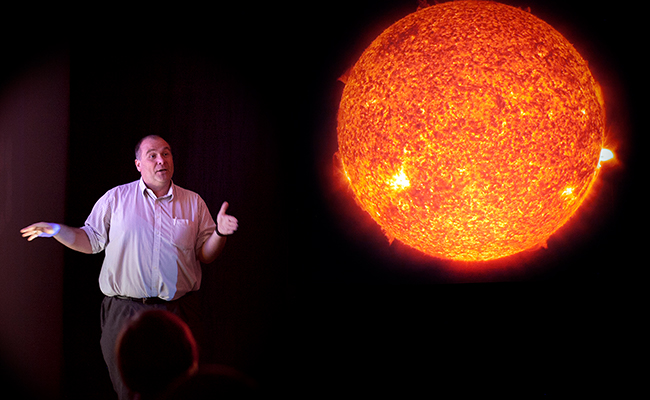Tuesday 29 September 2020 9:49am

Head of Department of Physics Professor Craig Rodger has received $15 million in project funding.
Each day we see the Sun rise and fall 150 million kilometres distant from Earth.
It’s us of course who are doing all that rising and falling as our planet is held in a gravitation grip by the Sun, and this gives us some advantages including a stable orbit and support for our very existence on this planet.
However, there’s also a flip side, as we are also surrounded by the Sun's magnetic field.
While our planet’s magnetic field protects us from the worst of the Sun’s harmful radiation, Head of Department of Physics Professor Craig Rodger says big space-weather events can have huge consequences for our electricity networks and technologically-dependent world.
To help address those risks Professor Rodger has recently received just over NZ$15 million for a five-year research project to develop space-weather prediction and risk mitigation measures for New Zealand's energy infrastructure.
The project is the largest funding Otago has received from the Ministry of Business, Innovation and Employment (MBIE) Endeavour fund, and includes ten national and international collaborators, about 20 named investigators and a total of 45 funded positions.
It was in 2014 when Professor Rodger’s work in space-weather really started to gain traction in New Zealand when he was first funded to undertake research on the emerging hazard.
“That initial MBIE-funded project really helped facilitate links to local industry like Transpower, and while that research identified that the risk from space-weather events was real, this current funding will allow us to really understand, assess and plan for this risk.”
“Moving into this area of research which is addressing questions that may help New Zealand become a better place and to see a direct benefit to people is a nice feeling.”
“Any event that disrupts New Zealand’s power and technological networks will have huge financial and societal impacts.
“We have already thought about this for earthquakes and tsunami, so this new investment in space weather risk mitigation is sure to also lead to beneficial outcomes.”
Over the last five years Professor Rodger has used both his knowledge and extensive network of international contacts developed through his career to plan for this New Zealand-focused research to take place.
“New Zealand doesn’t have the resources to address the stretch that our industry partners wanted, so I called upon the skills, tools, and capabilities across my international networks.”
The plan for the project is to bring this international capability together for the application and benefit of New Zealand’s energy infrastructure.
“Models of space-weather are by their nature global in context, but the outputs of these models can be quite geographically specific.”
“By doing and applying this science to the New Zealand context we are also aiming to contribute to the global capacity and grow knowledge in this area as well.”
The project team is led by Otago’s Department of Physics, but also involves academics from the Department of Mathematics and Statistics including Dr Matthew Parry, and also Dr Ting Wang who has undertaken similar work on seismic hazards.
The primary New Zealand industry partners include Transpower New Zealand and First Gas Limited, and GNS is assessing electrical properties of ground in areas where this information is not available, so the effects of space-weather events can be determined.
“If you think about what Geonet has achieved for the measurement and recording of seismic events, we would like to prepare for the space-weather hazard in a similar way,” Professor Rodger says.
The project also involves the Otago Museum to undertake outreach activities on the subject of space-weather to engage and excite young communities in this ‘new’ area of science.
Professor Rodger says that almost all the research he has undertaken to date has been based around fundamental science on space-weather physics, so he appreciates the shift to the applied nature of the upcoming project.
“Moving into this area of research which is addressing questions that may help New Zealand become a better place and to see a direct benefit to people is a nice feeling.”
We should never lose sight of where these projects really begin however.
As a child, Professor Rodger had a few obligatory solar system posters on his wall but one day as a second-year physics student he found a door on the fifth floor of the Department labelled Space Physics Lab.
That’s where it all started.
Story by Guy Frederick, Communications Adviser (Sciences)
